
November 17 - 30, 2022 Volume 13 // Issue #23 “THE LAST LAP” OF THE LONE PEAK TRAM PUBLIC COMMENT ON CRAZY MOUNTAIN LAND SWAP LONE MOUNTAIN LAND COMPANY’S DEVELOPMENT PLANS 'ACTION PACKED' RESORT AREA DISTRICT MEETING A PAIR OF SKI FILMS PREMIERE IN BOZEMAN PLUS: BADGER COMMENTS ON SOCIAL MEDIA SHAMING
MANAGING EDITOR
Jason Bacaj | jason@theoutlawpartners.com
DIGITAL PRODUCER
Julia Barton | julia@theoutlawpartners.com
STAFF WRITER
Jack Reaney | jack@theoutlawpartners.com
EDITORIAL CONSULTANT
Leslie Kilgore | media@theoutlawpartners.com
CREATIVE
LEAD GRAPHIC DESIGNER
ME Brown | maryelizabeth@theoutlawpartners.com
SALES AND OPERATIONS
CHIEF EXECUTIVE OFFICER
Megan Paulson | megan@theoutlawpartners.com
CHIEF OPERATING OFFICER
Treston Wold | treston@theoutlawpartners.com
VP OF SALES
EJ Daws | ej@theoutlawpartners.com
MEDIA AND EVENTS DIRECTOR
Ersin Ozer | ersin@theoutlawpartners.com
MARKETING MANAGER
Sophia Breyfogle | sophia@theoutlawpartners.com
CONTENT MARKETING STRATEGIST


Mira Brody | mira@theoutlawpartners.com
EVENTS AND MARKETING COORDINATOR

Tucker Harris | tucker@theoutlawpartners.com
SENIOR ACCOUNTANT
Sara Sipe | sara@theoutlawpartners.com
BUSINESS DEVELOPMENT LEAD

CONTRIBUTORS
Kaley Burns, Dan Egan, Marne Hayes, Rachel Hergett, Paul Swenson, Pepper Trail and Cy Whitling
ON THE COVER:
TABLE OF CONTENTS
“THE LAST LAP” OF THE LONE PEAK TRAM
Legendary Bozeman alpinist Tom Jungst is known for his days at Bridger Bowl, but his Big Sky ties run deep. He skied Lone Mountain by helicopter while filming for Warren Miller Entertainment and worked on the Lone Peak Tram’s construction in 1995. Jungst reflects in the first segment of a three-part series commemorating Big Sky’s revolutionary tram.
PUBLIC COMMENT ON CRAZY MOUNTAIN LAND SWAP
A proposed land exchange would allow permanent public access and improved trail connectivity in the eastern Crazy Mountains, where a checkerboard of private land has caused years of access disputes and legal conflict. The land swap would also involve 2 miles of the Inspiration Divide trail near Big Sky where it currently crosses Yellowstone Club property.
'ACTION PACKED' RESORT AREA DISTRICT MEETING
At the monthly, public BSRAD board meeting, topics included an update on Post Office negotiations, budget adjustments for the Big Sky Community Housing Trust and Morningstar Learning Center, public naming of non-compliant businesses, a statewide healthcare program hosted by the Big Sky Chamber of Commerce and an updated Capital Improvement Plan.
LONE MOUNTAIN LAND COMPANY’S DEVELOPMENT PLANS
FOR
TOWN
EDITORIAL POLICY
Outlaw Partners, LLC is the sole owner of Explore Big Sky. EBS reserves the right to edit all submitted material. Printed material reflects the opinion of the author and is not necessarily the opinion of Outlaw Partners or its editors. EBS will not publish anything discriminatory or in bad taste.

LETTERS
express
Matt Kidd, LMLC managing director, commented on the company’s efforts to build workforce housing for Big Sky. He also offered thoughts about a public event space, such as an outdoor amphitheater or rodeo arena.
A PAIR OF SKI FILMS PREMIERE IN BOZEMAN
“Somos” debuted on Nov. 9 at the Rialto in Bozeman, focusing less on the snowboarders and more on the mountains. The film was narrated in Spanish. “Nexus” is a storytelling-forward collage of 10 rad skiers, all of them women and premieres on Dec. 2 at the Bomb Snow Film Festival.
TO THE
to the editor
Sky unauthorized reproduction prohibited EDITORIAL POLICIES The Lone Peak Tram first started running in 1995 and elevated in-bounds American skiing. This upcoming season is its final one in operation before Big Sky Resort unveils its new tram a year from now. PHOTO COURTESY OF
ADVERTISING DEADLINE For the November 30, 2022 issue: November 23, 2022 CORRECTIONS Please report errors to media@outlaw.partners.

OPENING SHOT
14 11 8
explorebigsky explorebigsky #explorebigsky @explorebigsky
EBS welcomes obituaries written by family members or from funeral homes. To place an obituary, please submit 500 words or less to media@theoutlawpartners.com. EDITOR
Letters
allow EBS readers to
views and share how they would like to effect change. These are not Thank You notes. Letters should be 250 words or less, respectful, ethical, accurate, and proofread for grammar and content. We reserve the right to edit letters and will not publish individual grievances about specific businesses or letters that are abusive, malicious or potentially libelous. Include: full name, address, phone number and title. Submit to media@outlaw.partners.
@TOMCOPHOTO FOR BIG SKY RESORT OBITUARY LOCAL SPORTS A&E BUSINESS OPINION FUN BACK 40 4 6 23 24 26 28 38 42 November 17-30, 2022 Volume 13, Issue No. 23 Owned and published in Big Sky, Montana
OUTLAW PARTNERS & EXPLORE BIG SKY P.O. Box 160250, Big Sky, MT 59716 (406) 995-2055 • media@theoutlawpartners.com © 2022 Explore Big
TOM COHEN
PUBLISHER
Eric Ladd | eric@theoutlawpartners.com EDITORIAL
DAILY NEWS, STRAIGHT
Patrick Mahoney | patrick@theoutlawpartners.com SCAN
CRIER NEWSLETTER.
TO YOUR INBOX.
13 23
The Big Sky Community Theater hosted two sold out shows of “Clue” at the Warren Miller Performing Arts Center in November, bringing a wide swath of Big Sky locals to the stage for a fun-filled interactive performance. PHOTO COURTESY OF ASHLEY DODD





JOSEPH GILLISPIE OBITUARY
Joseph Gillispie passed away at home in McAllister on Nov. 2, 2022. He was with family and two beloved retrievers, Bingo and Saca.
Joseph Henry Gillispie was born in Falls City, Nebraska at Nebraska Hospital on Nov. 19, 1927 to parents Dr. James Charles Gillispie and Rose Mary (Redfern) Gillispie. The youngest of four children, Joe attended elementary school in Falls City, and often went on medical calls with his father, who was for some time the only doctor in Richardson County, Nebraska. When Joe was attended high school, he got special permission from his parents at age 17 to enlist in the Navy. On Nov. 16, 1945, Joe graduated from Hospital Corps School. Even though Joe was stationed in Pearl Harbor, he was graduated from Falls City High School in May of 1946. Joe always said his mother bribed the principal with hams so he could graduate while serving in the Navy.
After leaving the U.S. Navy, Joe attended Kansas State University and Peru State College in Peru, Nebraska, graduating in 1951. Seeking adventure, Joe signed up to work for Atlas Constructors/Morrison-Knudson in Casablanca, French Morocco. Among other duties, he ran the movie theater in the Recreation Hall. Upon returning to the U.S., Joe and Marcene McCunn were married on June 6, 1953 at St. Clair in Clarinda, Iowa. There were four children born to this union: Teresa Ann, Mary Jo, James Charles and John Joseph. Joe was a pharmaceutical representative for Carroll, Dunham Smith for two years and worked nearly 40 years for Schering-Plough (now Merck).

hunting, hiking with the Big Sky Hikers, and Joe began his woodworking hobby that later turned into artistic expression through his furniture creations. In 2015,
the Gillispies made their move to the Madison Valley and their home in McAllister. At last, Joe had a great workshop, and turned to making furniture with gusto.
One of Joe’s great joys was fall pheasant hunting in North Dakota, with golden retrievers, Jackson and Murphy. The birds were prolific, Joe was a great shot, and Jackson and Murphy never left a bird in the field.
Another passion Joe enjoyed was cooking such treats as a rare roast beef with morel mushrooms.
Joe was preceded in death by his parents, Dr. James and Rose Gillispie, siblings Margaret Shaffer, James Gillispie, Mary Jane Lang, and wife Marcene (McCunn) Gillispie. Joe is survived by his wife, Barbara, children Teresa (Scott) Stoner, Mary Jo Gillispie, James (Lisa) Gillispie, John Joseph Gillispie, 13 grandchildren, 15 great grandchildren, and many nieces and nephews. A special thank you to Dan & Kathy Olkowski, Judy Maddox, Cliff & Debbie Schenk for their love during this difficult time. Internment will be in the Pony at Valley View Cemetery with military honors in Summer 2023.

In lieu of flowers, donations are suggested to: Public Lands/Water Access Association, the Jack Creek Preserve Foundation, Caring & Sharing Food Bank, or Madison Valley Public Library. After all, nothing was more important to Joe than being outdoors, education, good food and good books.
This gentle man will be greatly missed by family and friends.
Explore Big Sky 4 November 17-30, 2022
In June of 1983, Barbara Christensen and Joseph were married in Steamboat Springs, Colorado during a balloon festival. They traveled to Jackson, Wyoming and Big Sky, Montana on their honeymoon. After living 10 years in Grand Island, Nebraska on the Wood River and hearing the calls of the sandhill cranes in the Spring and the Fall, Joe and Barbara moved West to the mountains of Big Sky, Montana. Their life was full of fly fishing,






LOCAL
NEWS IN BRIEF
NUMBER OF ELK KILLED IN COLLISIONS ON HIGHWAY 191 CLIMBS
EBS STAFF
Roughly 20 elk have been killed by drivers in recent weeks on U.S. Highway 191 between Gallatin Gateway and the mouth of Gallatin Canyon.
The first weekend of November saw four elk killed in two separate accidents, according to Holly Pippel, a longtime Gallatin Valley local and photographer who has followed elk herds near Gallatin Gateway for the past seven years. One driver on Nov. 5 struck two cow elk and a calf, all of which were killed. Another cow elk was struck and killed late in the day on Nov. 6. Neither driver was injured.
Gallatin County officials are expected to place variable message boards along that stretch of road to warn motorists of wildlife crossing dangers.
STRONG EARLY SNOWPACK LEADS BIG SKY RESORT TO OPEN EARLY
EBS STAFF
In a press release on Tuesday, Nov. 15., Big Sky Resort announced that lifts will spin on Nov. 23, one day earlier than the planned Thanksgiving opening date.

This announcement comes after more than 5 feet of early season snow, according to the release. The mountain will be open to all visitors, including day-ticket, Ikon Pass and Mountain Collective passholders. Lift ticket offices will open for pass pickup for the season on Monday, Nov. 21 from 8-4:30 p.m.
Swift Current 6, Explorer, Challenger and Iron Horse are the four lifts expected to open, reportedly serving some 2,000 skiable acres. Ramcharger 8 will open on Thanksgiving. The release noted that terrain offerings are being assessed daily by mountain operations.
YELLOWSTONE VISITS DIP IN OCTOBER
EBS STAFF
Visits to Yellowstone National Park in October dipped 27% compared to last year, according to figures released by the park. So far in 2022, the park has hosted more than 3.2 million, down 32% from 2021 at the same time.
The more than 232,000 visits were a 36% increase from October 2019, which was the last year before the global COVID-19 pandemic.
In mid-June, historic flooding caused YNP to close all its entrances and evacuate visitors. On June 22, the East, South and West entrances to the park reopened on a limited entry basis. The last entrances reopened to regular visitor traffic on Oct. 15 and on Oct. 30.
Visitors traveling to the park this winter should stay informed about what's open and closed.
ESPN’S COLLEGE GAMEDAY COMES TO BOZEMAN FOR RIVALRY GAME
SKYLINE SPORTS
On Sunday morning, Nov. 13, College GameDay’s twitter account announced that college football’s most famous pre-game show will descend upon Bozeman. Or, as they’ve dubbed it, “The Big Sky City”.
Montana State’s football team is in the midst of a fourth straight playoff run. MSU is 7-0 in league play, 9-1 overall and ranked No. 3 in the country entering the 121st showdown with rival Montana on Saturday, Nov. 19.
The Griz are 4-3 in Big Sky play, 7-3 overall after a pair of dominant wins that followed a three-game October losing streak by the preseason league favorites.
The College GameDay national broadcast will begin at 5:45 a.m. in what’s forecasted to be classic chilly Montana fall weather.
A HOT COMMUNITY MEAL AND THANKSGIVING SUPPLIES
EBS STAFF
On Monday, Nov. 21 from 4-7 p.m., anyone is welcome for a hot “Friendsgiving” meal at the Wilson Hotel, provided by Sweet Buns Catering with support from the Hungry Moose and Roxy’s Market.
In addition, the Big Sky Community Food Bank will provide “Thanksgiving in a bag.” All traditional ingredients, including a turkey, sides and desserts will be packed up and available for pickup on Monday, Nov. 21. Anyone can sign up by visiting the food bank or by calling (406) 995-3088 before Friday, Nov. 18 at 3 p.m.
Sarah Gaither Bivins, food bank operations manager, thanked the Lone Peak Honor Society for their Thanksgiving food drive, Chuck and Kris Schommer for donating 36 turkeys and Big Sky Build for providing desserts and staples.
Explore Big Sky 6 November 17-30, 2022





All information given is considered reliable, but because it has been supplied by third parties, we cannot represent that it is accurate or complete, and should not be relied upon as such.These offerings are subject to errors, omissions, and changes including price or withdrawal without notice. All rights reserved. Equal Housing Opportunity. If you currently have a listing agreement or buyer broker agreement with another agent, this is not a solicitation to change. ©2016 LK REAL ESTATE, llc. lkrealestate.com * Membership upon approval NOW LEASING Rental inquiries should be directed to Connect Property Management, LLC. Call (406) 587.0344 for more information S CAN FOR INFO 2 Bedrooms | 2 Baths | 5242 Fallon Street, Bozeman, MT
LOCAL
THE LAST LAP A LEGEND’S EARLY TRACKS AND TRAM WORK
“The Last Lap” is a three-part series commemorating the origins, glory years and final days of a defining era for American skiing.
 BY JACK REANEY
BY JACK REANEY
BIG SKY—Before the Lone Peak Tram, Lone Mountain was tracked by local legends. Tom Jungst is one of them.

Nine years after Pat Callis, called “the godfather of [Bozeman] area climbing,” made the first ascent of the Lone Mountain face below the current tram in 1968, Jungst moved to Montana and began ski racing at Montana State University. In 1977, Jungst began a life of extreme skiing which earned him fame, especially around Bridger Bowl when he rode women's downhill skis, “210 [centimeters long], nothing less.”
However, Jungst said he was the only member of his hot-dogging Bridger crew who also spent significant time in Big Sky.
For years, he would hike up Lone Mountain or the A-Z chutes alone while ski patrol watched with binoculars. In October 1977, he began a “common fall ritual”: a weekend camping in the unlocked, uninsulated shack atop the Lone Peak Triple. That’s when he first skied the Big Couloir—the first lap of hundreds, he said, a small number compared to the “thousands” done by some hardcore locals.
Since Big Sky Resort announced their “long awaited” plan to replace and re-route the iconic Lone Peak Tram, the prospect of Big Sky’s new era has captured international and local attention. However, another reality looms in the hearts of long-time locals, workers and visitors: if all goes according to plan, the winter of 2022-23 will write the final chapter for an iconic machine which revolutionized American in-bounds skiing and denied the impossibility of bringing thousands to the peak of Lone Mountain. In part two, EBS will feature two teams that launched explosives and greased gears to make the whole thing work.
'Equal to any European Resort’
“People think of me as a Bridger skier, like, only,” Jungst told Explore Big Sky. But Big Sky Resort gave him a free ski pass in his MSU days and he took advantage of it, unlike most of his teammates.
Jungst gives Bridger credit for creating very technically adept skiers; he was deeply involved with the culture of Bridger’s Ridge. Big Sky is “big skiing,” he said, and Lone Mountain breeds skiers capable of going to bigger mountains.
In the late ‘80s, Jungst was filming at Big Sky for Warren Miller Entertainment with fellow extreme skiing pioneer Scot Schmidt and “tough as nails” cameraman Gary Nate. After riding a helicopter to Lone Peak, John Kircher, resort general manager, asked Jungst and Schmidt what they thought about a tram.
They were fascinated. They said it would be amazing. Jungst recalls telling Kircher, ‘it would put Big Sky equal to any European resort.’
The tram was well-documented as a preposterous idea. But Jungst credited Kircher—a young Big Sky executive and son of Boyne Resorts owner Everett Kircher—and said he was “a super hard-charging skier” that foresaw the in-bounds potential of Lone Mountain’s terrain. Kircher was also impatient, Jungst said. He didn’t wait around while the Warren Miller crew prepared to shoot.
“He never even said, ‘Oh, you should film me,’” Jungst recalled. “He would ride in the helicopter and then just rip off and ski somewhere else.”
Just a few years later, by virtue of Kircher’s persistence, Jungst was working as a surveyor and welder on the incoming Lone Peak Tram.
A moonlit arc
“We were the last people to climb it and ski it before construction started,” Jungst said. “We skied the Big Couloir, it was really awesome. The helicopters came up while we were coming down.”
It was May of 1995. Jungst said construction began slowly because of all the snow on the ground. Then, they faced a summer full of thunderstorms.
“They would helicopter us [to the job site] a lot of times in the morning. If the weather wasn’t good, you’d have to hike [up, and] you’d have to run down if the lightning was hitting,” Jungst said. The helicopter couldn’t retrieve the workers during a storm.
Explore Big Sky 8 November 17-30, 2022
Jungst carves into Challenger chalk in 2016. PHOTO COURTESY OF TOM JUNGST
Jungst rappels from the tram in October 1995, trying to yank “a mess of cable” around the bull wheel. About a week later, they fastened cars onto the cable, and Jungst was one of the first riders.
PHOTO COURTESY OF TOM JUNGST
By September, Jungst said he was working every day—the resort provided lodging, food and handsome daily pay. He took only one break in mid-October, visiting Yosemite National Park for a 13-day climb of El Capitan via the Tempest, and got right back to work.
By the time ski season arrived in late November—the tram would eventually open on Dec. 23—Jungst had a routine. He was doing detail welding alone; the more highly-certified welder had already finished the tram’s most critical joints and departed from Big Sky.
“I would get up in the morning,” Jungst said. “I would go down and have free breakfast at the lodge. I’d ski for a few hours, have a [free] massage, then lunch. Then I would ride the lifts up [to the bowl], and I would hike up top with my skis and work ‘til about midnight.”
Surprisingly, Jungst wasn’t working alone in the moonlight. Engineers from Doppelmayr worked into the night to communicate with counterparts in Austria.
“I’ve met people that remember seeing [my welding] arc up there at night. It was super bright. And then I would usually ski down the Big Couloir alone, by headlamp, and ski to Whiskey Jack’s and close it down.
“I’m 65-years-old now, and I think, ‘Oh my god,’” Jungst said, laughing.
On that day in December when the tram opened, Jungst said he was still welding handrails on the high catwalk of the lower terminal, trying not to let sparks fall down on skiers as they waited in line.
Another engineering feat
Jungst said Big Sky’s new tram will be just as dramatic as the original one.
“To me, it’s an engineering feat that they’re going to put that size tram up there,” he said. “I look at the rendering... It’s crazy.”
In 1995, Jungst knew his experience on Lone Mountain was going to change.
With tram access, he would seldom hike to the silent peak, straight up the ridge from the triple chair with “First Gully” on his left. After 1995, the peak would be crowded and common, a much less daring place to ski.

A few years after the tram took in-bounds resort skiing to the next level, continued ski area development made “Three Forks” the crown jewel of Moonlight Basin’s headwaters. In the early 80s, though, Jungst remembers that nobody would ever ski down the north side. It was another frontier to explore.

One day, Jungst and Doug Coombs—another ski legend—went for it. They reached the bottom and spent hours hiking out through a mess of fallen lodgepole pines. Jungst said it was a perfect day. Now it’s in bounds, skied most winter days by ridge hikers.
“It feels like a lifetime has passed when I look at these photos,” Jungst said.
Jungst could have rejected the change and bailed on Big Sky, especially after patrol began enforcing strict boundaries on his favorite terrain—one friend was “busted” for snowboarding a line under the tram, and access to the Big Couloir access became controlled. But when the Lone Peak Tram opened, Jungst said it simply replaced his need to visit Europe. And when the tram line is too long, he said he just heads to Challenger—another special area for Jungst.
“My favorite thing is to get out of the tram and not rush. I take three minutes more, and everyone’s gone—like it’s a race,” said Jungst, who also enjoys wind and whiteout conditions for the short tram line. “I like that moment when everyone’s gone.”
Big Sky Resort will soon cut the ribbon on a new tram designed to increase cabin capacity from 15 to an undisclosed number—renderings suggest more than 75 riders. Jungst knows the experience will change again with so many skiers at the top.
“I don’t feel like I’ll have that moment again. That private moment that I love about all mountains,” he said. “Unless it’s a really bad day. So bad that nobody will go. [I’ll] be there.”
Jungst said it’s a lot easier to be “the last” to do something than it is to be first. He was proud to be the last to descend the Big Couloir before tram construction. He attempted to ride the last chair of the Lone Peak Triple in April 2016, but another guy nabbed it.
With regards to the last lap of the old tin can, Jungst said, “we’ll see.”
Explore Big Sky 9 November 17-30, 2022 LOCAL
Jungst and legend Doug Coombs skied this line (marked in red) down the face in 1988. They were forced to down-climb the rocky “ramp” near the top, and Jungst said that every time he rides the tram, he looks down at the rocks and wishes they could have skied the route continuously.
PHOTO COURTESY OF TOM JUNGST
Jungst carves a turn on the “cue ball” beneath the Big Couloir. PHOTO COURTESY OF TOM JUNGST

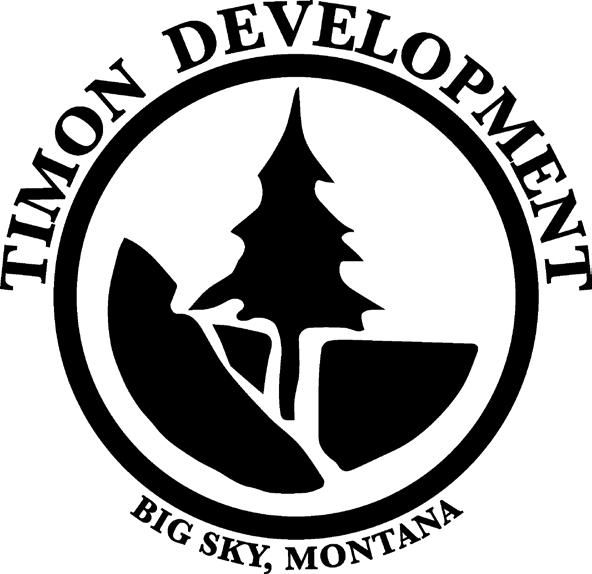
CERTIFIED PROFESSIONALS TO SERVE YOU. Local craftsman for unique, custom projects and on-site property management. TIMONDEVELOPMENT.COM TIMONDEVELOPMENTLLC@GMAIL.COM
ON
INSPIRATION DIVIDE LAND EXCHANGE
BY JACK REANEY
A proposed land exchange would allow permanent public access and improved trail connectivity in the eastern Crazy Mountains, where a checkerboard of private land—first federally granted in alternating square-mile plots in the 19th century—has caused years of access disputes and legal conflict. The land swap would also involve two miles of the Inspiration Divide trail near Big Sky where it currently crosses Yellowstone Club property.
The Custer Gallatin National Forest issued a press release announcing the long-discussed proposal on Nov. 9, opening a 45-day period for public comment on the preliminary environmental assessment.


The online portal for public comment will remain open until midnight on Dec. 23. Public meetings are scheduled in Bozeman on Nov. 15, from 6 p.m. until 8 p.m. at the Commons at Baxter and Love and in Big Timber on Nov. 16, from 6 p.m. until 8 p.m. at Big Timber Elementary School.
In the Crazies, the Forest Service would exchange about 4,135 forest acres for 6,430 acres of private land mostly at high elevation that allows for trail improvements in the Crazies. Among the improvements are a connector between Big Timber Canyon and upper Sweetgrass Canyon and 22 miles of trail to complete a loop around the Crazies and allow public access to Smeller Lake.
In a press conference, Custer Gallatin Forest Supervisor Mary Erickson expressed her desire that the public “take a hard look at [the] documents” to avoid disinformation. By reading the preliminary environmental assessment, she hopes the public will respond with informed questions and comments and attend the public meetings.
“There’s some pretty wild rumors out there,” Erickson said, including one about the YC’s involvement. She said she’s heard concerns about a possible ski resort development in the Crazy Mountains.
“The Yellowstone Club is helping facilitate an assembled land exchange. They would acquire property in exchange for federal lands only in the Big Sky area,” Erickson said,
pointing out that the exchanged land in the Crazies will remain under ownership of the six involved ranchers.
The YC has hired land exchange consultants and would pay for trail construction in the Crazies, according to a 2021 report from the Montana Free Press.
“As a life-long Montanan and an avid outdoorsman, I know the significant role that our public lands play in our way of life and local economies,” YC executive Mike DuCuennois wrote to EBS. “This land exchange is about improving access to quality public lands in both the Crazy Mountains and the Madison Range.”
While supporting the exchange in the Crazies, the YC offered 600 acres to the Forest Service to improve Big Sky’s public-access Inspiration Divide trail where it crosses that private land. In exchange, YC would receive 500 acres of Forest Service land adjacent to their property to develop lift-access expert ski terrain.
The land exchange was facilitated in part by the Crazy Mountain Access Project, a coalition of ranchers, conservationists and hunters that was formed in 2019. DuCuennois is a member of the project.
Erica Lighthiser, CMAP member and deputy director of the Park County Environmental Council, noted in a release about the proposal the long-term importance of consolidating public land in a checkered landscape vulnerable to development.
“The improved public land consolidation in this land exchange will not only clarify where the public has legal access, but will allow the U.S. Forest Service to better protect and steward the wildlife habitat and important cultural sites in the Crazy Mountains,” Lighthiser stated in the PCEC press release.
The Crazy Mountains also have spiritual significance to the Crow tribe, among others, but private land ownership has complicated their modern-day access.
“This Crazy Mountain Land Exchange is an important agreement negotiated by local Montanans, and it deserves [public] support because it is a win-win for both public and private landowners and settles decades of conflict around access to the mountains,” Dr. Shayne Doyle, Apsáalooke (Crow) and CMAP member, stated in the release.
“As one of Montana’s most iconic and centrally located island mountain ranges, they’ve been locked up and off-limits on the east side for long enough,” Doyle stated. “It’s time to move forward with this plan that will connect people to one of our state’s greatest treasures— the sacred Crazy Mountains.”
Written public comments may also be submitted by mail to ATTN: Forest Supervisor Mary Erickson, PO Box 130, Bozeman, MT 59771
Explore Big Sky 11 November 17-30, 2022 LOCAL
RECREATIONAL ACCESS
proposed land exchange would consolidate Forest Service land (green). Proposed connector trail is shown in yellow. PHOTO COURTESY OF THE U.S. FOREST SERVICE
PUBLIC COMMENT OPENS
CRAZY MOUNTAINS, BIG SKY’S
PROPOSAL WOULD CONSOLIDATE PUBLIC LAND, PRESERVE TRIBAL AND
The
“checkerboard”
THE U.S.
SERVICE
The existing
of property ownership in the eastern Crazy Mountains. PHOTO COURTESY OF
FOREST






MEETING
BY JACK REANEY
BIG SKY—The November Big Sky Resort Area District board meeting sparked action and a few surprises, including a report from the Big Sky Chamber of Commerce that holiday lodging projections rose in the past week from a quieterthan-average outlook, likely based on recent snowfall.

Included among the action were: an update on Post Office negotiations, updated procedure regarding the public naming of non-compliant businesses and a new health care program from the Big Sky Chamber of Commerce.
A PUBLIC POINT’ ON REPEAT NONCOMPLIANT BUSINESSES
According to Danny Bierschwale, executive director of BSRAD, Big Sky business registrations opened on Nov. 1.
“The information compiled by business registrations is becoming more important for our community as we’re seeking to get solid data from our economic activity,” Bierschwale said. “These registrations are legally required, and we’re leaning into them.”
After the update, the board faced a related action item: repeat non-compliant businesses.
Bierschwale said numerous have remained on the non-compliant list for four or more years due to resort tax delinquency and other BSRAD policy violations.
“We are very generous with our timelines before we start triggering a legal and higher-tier compliance [penalties], which would include things like revoking a liquor license, filing a lawsuit, penalties, fines, fees, all that fun stuff.”
Bierschwale confirmed that BSRAD can legally publish a list of repeat tax delinquency in local publications, and this resolution was added to the agenda “to make a public point that this is a tool in our toolkit.”
He added that BSRAD tries to work with businesses struggling to stay in compliance, “but [they] aren’t there yet,” he said.
Director Kevin Germain said he squirmed when he read the proposed resolution.
“Confidentially is such an incredible thing that this board and staff maintains,” he said. “This would be going public with tax information, and non-compliant businesses. I’m not taking this one
lightly.”
Director Grace Young said that BSRAD begins to file lawsuits after 120 days, making information public at the Gallatin County Courthouse before being publicly listed by BSRAD.
According to the proposed procedure, BSRAD would name non-compliant businesses if they are 210 days—seven months—late in resort tax payment. The procedure would not list specific details including deficit amounts.
The board unanimously approved the resolution and will return with more specific information at the January BSRAD meeting.
LOWER-COST HEALTH CARE FOR MONTANA BUSINESSES
Citing the 16% year-over-year increase of the cost of providing health care to employees, Big Sky Chamber of Commerce CEO Brad Niva presented a plan for the Chamber to provide affordable health care for employers statewide.
In partnership with United Healthcare, the Big Sky Chamber will offer health care to small Montana businesses—fewer than 100 employees—that partner with their local chamber of commerce and pay $150 per year for a discounted membership with the Big Sky Chamber.
Niva saw the recent success of a statewide chamber-member health plan in Bend, Oregon before taking the helm at the Big Sky Chamber in 2021. He adapted the model to fit the industrial needs of Montana, where Niva said almost 80% of employees depend on health insurance from their employer.
“This has taken me 14 or 15 months to get going, but we launched it last week,” Niva told the board.
AN OUTDATED CAPITAL IMPROVEMENT PLAN
“Every planning board and zoning district needs to have [a CIP] and state law requires that they be updated every five years,” Steve Johnson said.
The most recent zoning board CIP was filed in 2011, which surprised board members.
Johnson said responsibility would typically fall on the Gallatin County Big Sky zoning district, but Germain suggested the next step is to submit a request for proposals to qualified vendors to create a CIP for the Resort Area District instead.
“It’s going to be really important for our community to make sure that all of the large-scale
capital investments are built into that CIP before that moves forward,” Bierschwale told EBS.
‘TAX EDUCATION 102’
Bierschwale said BSRAD wants to make sure all taxes are being handled equitably, and that the community needs to understand how the current system works.
In the past year, BSRAD created a guide which Bierschwale called “tax education 101,” explaining how much is collected, who pays, who collects, and where funds go. The guide helped explain resort tax, lodging facility sales and use tax, and property tax.
Now, Bierschwale said it’s time for “tax education 102,” intended to demystify property taxes. He believes that especially for Big Sky residents in Madison County, property taxes create confusion.
“I can’t look at [a tax bill] and understand it without some help,” he said. “And we want to help.”
BSRAD staff plan to release a document to explain tax information in the months leading up to tax season.
POST OFFICE NEGOTIATIONS
Al Malinowski of Gallatin Partners, the firm that recently announced it would terminate its contract with the USPS come February, gave an update at the BSRAD meeting.
“I’ve had some short dialogues with the counterpart I deal with in Denver, I’ve really had no direct communications with anyone else at USPS which is unfortunate, I hoped they would have reached out,” Malinowski said.
Despite communication with certain representatives, he said that with the bureaucracy of the postal service, by the time any discussion reaches the level of decision makers, “it seems to be a very different message and a very incomplete message.”
The USPS is looking to find a similar contractbased partner to host a contract postal unit, which would fail to address the needs Malinowski has seen in his two decades operating Big Sky’s mail service. Demand has grown bigger than Gallatin Gateway and West Yellowstone, he said. Both of those postal zones are serviced by a federal office, he said, pointing to the need for a similar upgrade in Big Sky.
Malinowski estimated that an ideal 5,000-7,000-square-foot facility would cost between $500,000 and $1 million annually.
Explore Big Sky 13 November 17-30, 2022 LOCAL
‘
‘IN OUR TOOLKIT’ ACTION-PACKED BIG SKY RESORT AREA DISTRICT
The BSRAD board meets on the second Wednesday of each month at 9:00 a.m. at the Resort Tax office. The next meeting will take place on Jan. 11. PHOTO BY JACK REANEY
BY JASON BACAJ
BIG SKY—The Lone Mountain Land Company in October brought to the public some of its plans for further developing land it owns around Town Center, Meadow Village, Gallatin Canyon and Gallatin Gateway.

The Big Sky community needs about 2,000 housing units in the next decade, said Matt Kidd, LMLC managing director, during his presentation at the Community Builders Forum and Economic Outlook session that closed Community Week 2022. LMLC projects in the works are expected to add more than 1,200 housing units and more than 4,000 beds, Kidd said.
“Some stuff that we’re doing is very focused on dorm-style housing and a seasonal workforce,” Kidd said during the presentation. “Other stuff that we’re doing is… what we would view as local housing.”
Those projects include the expansion north of Gallatin Canyon around Gallatin Gateway Inn and housing near the Jump Restaurant and Marketplace. Farther south in the canyon, near Bucks T-4 Restaurant, Kidd said there are plans for rezoning land adjacent the Ramshorn
neighborhood and possibly re-zone land on the other side of Bucks, closer to the Conoco, for denser development.
Plans are also in development for a neighborhood of community housing behind the already-in-theworks RiverView apartment complex, since LMLC was able to aggregate about 180 acres of land. Additionally, Kidd said there are plans to expand the South Fork neighborhood by roughly another two dozen units, as well as plans for a “small extension” of the Grey Drake neighborhood by the Hummocks and Uplands trails.
He also floated the idea of some sort of events center—possibly an amphitheater, event barn or rodeo arena—around Town Center. However the plans turn out, Kidd said that LMLC is committed to improving trails and trail connectivity between neighborhoods and preserving open space— including improving access to the West Fork of the Gallatin River, potentially with a promenade connecting the Town Center plaza to the river.
“I can’t say for sure that it won’t happen, I can’t say for sure that it will happen,” Kidd said at the event. “We know we need events… we need programming to bring people here.”
Among the trail connectivity improvements planned are connectors to Michener and Mud creeks that may happen as early as next summer.
“We have more work to do,” Kidd said.
Explore Big Sky 14 November 17-30, 2022 LOCAL
INCLUDES MORE
LMLC BRINGS ROUGH DRAFT OF DEVELOPMENT PLANS TO THE PUBLIC
THAN 1,200 HOUSING UNITS, POTENTIAL FOR RODEO ARENA
An aerial view of Town Center. OUTLAW PARTNERS PHOTO














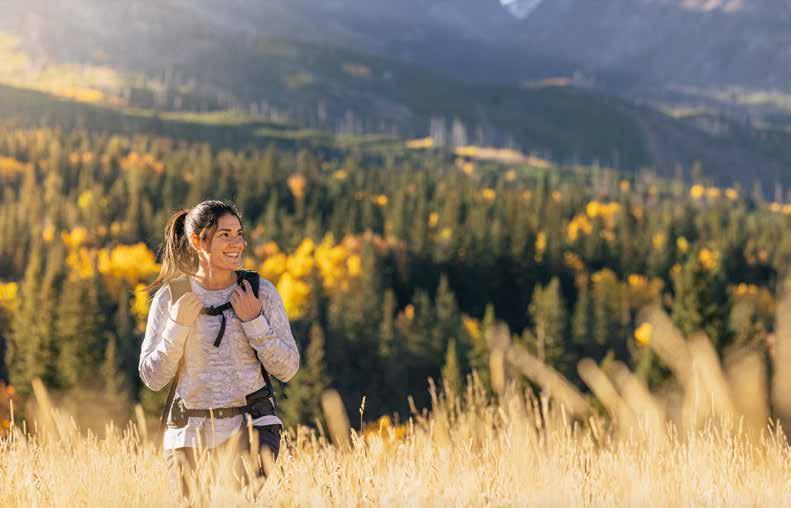


FALL / WINTER COLLECTION G E A R C O Z
U P S C A N H E R E T O S H O P N E W
Y
























Explore Big Sky 18 November 17-30, 2022 LOCAL
MOONLIGHT MOUNTAIN OASIS


Perfectly situated to take in breathtaking views of Lone Peak, Fan Mountain, Spanish Peaks and the Madison Valley, this luxury, mountain modern retreat strikes the perfect balance of sophistication and ski-style chic. The home features stone, steel and reclaimed wood with walls of windows to capture every possible view. Located on a quiet cul-de-sac, the spacious floor plan design is timeless, with 5 Bedrooms, 5 baths and 2 powder rooms provide a sanctuary where you can work, live, play, and entertain. On the main level, you will find a wood burning fireplace, living area, primary and secondary bedroom, as well as gourmet kitchen, dining room and large outdoor deck. Downstairs includes a second living area, 2 bedrooms, bunk room, bar, ski room complete with ski lockers and boot dryers and just steps from the ski trail and Big Sky’s slopes. Set for completion in late spring of 2023.
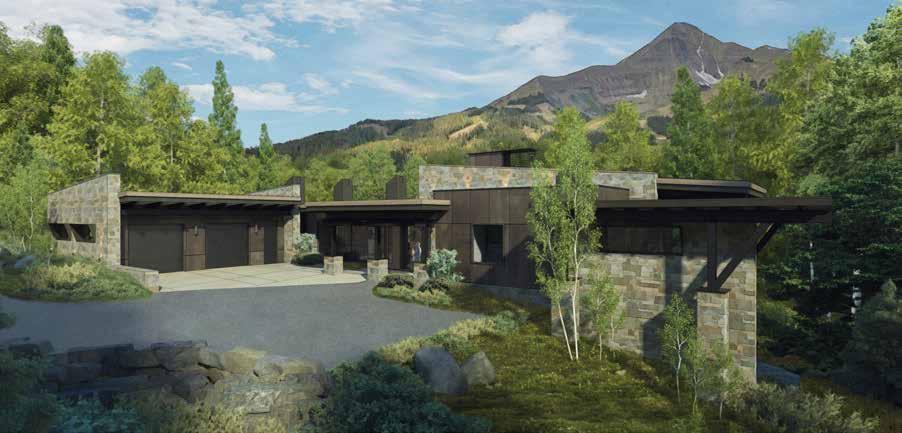


ALL INFORMATION PROVIDED IS DEEMED RELIABLE BUT IS NOT GUARANTEED AND SHOULD BE INDEPENDENTLY VERIFIED. INFORMATION AND DEPICTIONS ARE SUBJECT TO ERRORS, OMISSIONS, PRIOR SALES, PRICE CHANGES OR WITHDRAWAL WITHOUT NOTICE. NO GOVERNMENTAL AGENCY HAS JUDGED THE MERITS OR VALUE, IF ANY, OF THE INFORMATION CONTAINED IN THIS ADVERTISEMENT OR ANY REAL ESTATE DESCRIBED OR DEPICTED HEREIN. THIS MATERIAL SHALL NOT CONSTITUTE AN OFFER TO SELL IN ANY STATE OR OTHER JURISDICTION WHERE PRIOR REGISTRA TION IS REQUIRED OR WHERE SUCH AN OFFER WOULD BE PROHIBITED, AND THIS SHALL NOT CONSTITUTE A SOLICITATION IF YOU ARE WORKING WITH ANOTHER REAL ESTATE AGENT. NOTHING HEREIN SHALL BE CONSTRUED AS LEGAL, TAX, ACCOUNTING, OR OTHER PROFESSIONAL ADVICE.
Co-listed with Ania Bulis MLS # 378967 | 5 BED + 5 FULL BATH + 2 HALF-BATH | TWO-CAR GARAGE | 5,631 +/- SQ. FT. | $16,500,000 15 Wildrye Road | Moonlight Basin Mia Lennon Broker mia@bigsky.com 406.641.0051 View all my listings at bigskyrealestate.com/team/mia-lennon




















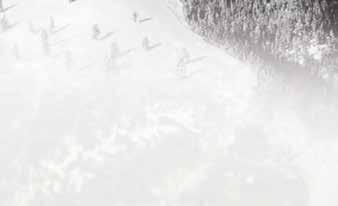





























































































































































ID Bozeman Ennis Big Sky West Yellowstone WY MT Montana ' s best products under one roof Scan for store info + shop online lonepeakcannabiscompany.com
BY JACK REANEY
BIG SKY—Shannon Corsi recalls moving to Big Sky “basically full gaper” for the winter of 2015-16 and learning to snowboard while working as an outfitter for Black Tie. She said she figured snow sports out on the fly.
‘On the fly’ might be Corsi’s style. She’s the director and executive producer of “Nexus,” an Arc’teryx-backed ski film that premiered on Oct. 5. She said it was the first film she ever worked on.
“It was a lot of huck and pray,” she told Explore Big Sky. “Nexus” intentionally rejects the ski industry entertainment norm that “one woman is enough”— which many world-class female skiers have heard throughout their careers—by featuring 10 women on the slopes. The film carries top-tier cinematic appeal, from dynamic time-lapses and slow-motion close ups to drone aspects and helicopter action reels. Unique segments show big mountain lines, backflips, backcountry powder and the simultaneous dropping of cliffs and beats— “Nexus” contains the usual elements of a ski film, except men.
Aside from gender, there’s another intentional difference on screen; there isn’t the constant ‘huck and pray’ action, the minutes-long powder highlights that viewers might expect from Warren Miller Entertainment or Teton Gravity Research. Instead, Corsi and her production team focused on telling the story of each athlete, with interviews digging deeper than snow. They explore their relationships between womanhood and the mountains, their bonds with fellow athletes and identity barriers within ski culture.
There’s still plenty of powder and dramatic mountaineering on screen—just with a higher dose of character.
Five unique pairs of women make up various segments of “Nexus.” The 43-minute film is narrated between segments by 70-year-old Jane Gallie and 67-year-old Margo Krisjansons, longtime Teton area locals who met in Nepal in 1981. They’ve seen the ski world grow to include women over their years, but spent most of their lives skiing in groups of mostly men.
Ingrid Stensvaag and Lucy Sackbauer also live in Jackson, Wyoming. The pair of nurses find balance and solidarity in their lives by exploring the backcountry or by squeezing in a quick groomer before a night shift in the hospital.
In her 19-year career, Red Bull athlete Michelle Parker had never ridden in a helicopter with only women, according to a “Nexus” press release. That changed in the Chugach Mountains of Alaska as she rode the chopper to shred big mountain lines with designer and professional biker Brooklyn Bell, in a segment about mentorship and synergy.
Both winners of Kings and Queens of Corbet’s, Caite Zeliff and Veronica Paulsen practiced making their own fun in Revelstoke, BC to open the film. They eventually find snow and send it.
In “Nexus,” cousins Sasha Dingle and Krystin Norman climb peaks around Crystal Mountain, WA. They were inspired to put their passions first by their mothers, who both escaped Vietnam right before the Fall of Saigon in 1975 and fell in love with skiing as young adults. They made sure their daughters had access to the mountains.
ADDING MORE BIPOC REPRESENTATION
Dingle and Norman weren’t originally part of the film script, but they reached out to the producers because they felt “Nexus” was missing something. A Montana State graduate and former Bozeman resident, Dingle spoke with Explore Big Sky.
Norman knew the project’s lead photographer, Katie Lozancich, from their work in professional mountain biking. After hearing about the ski film, Norman reached out.
Dingle said her cousin pointed out that, “something was missing and it was something we can add.”
“All the stories showed a wide variety of what it’s like to be a female athlete,” Dingle said. “We wanted to add an additional BIPOC story that kind of normalized that skiing for us was as normal as being a family… we kind of wanted to show the normalcy of that. We wanted to show a story where, in one generation, this can become a family activity––how quickly change can happen from really loving [skiing].”
Growing up as a competitive ski racer and transitioning into Freeride World Tour competition, Dingle said she didn’t always see her identity represented in the industry. Lacking a clear role model, she says she felt inspired and fearless without a precedent to limit her imagination, but being outside the majority group was also a stressor.
“I feel like I have not belonged in the ski industry, but I have always belonged to skiing,” Dingle said. “The language that connects [my family] is skiing. That felt like my first language in a way.”
Alpine racing in Vermont while Krystin grew up skiing moguls in California, they didn’t have many opportunities to ski, bike and compete together aside from a few family trips during childhood. Instead, they lived separate but parallel lives; Dingle says that while filming “Nexus” they skied together for the first time since middle school. Dingle and Norman reconnected three years ago through mountain biking.
“All this armor that I’ve worn as a woman in a male dominated industry, and as a BIPOC woman in a white dominated sport, that started to come off when I saw what Krystin was doing,” Dingle said. Both cousins have been deeply involved with biking, which Dingle said is outpacing skiing in terms of giving women dedicated event platforms such as the Red Bull Formation Series, Dark Horse Invitational and Thunder Struck.

Dingle moved west to race at MSU but wanted to explore skiing beyond the intensely focused culture around racing. She eventually competed in the Freeskiing
World Tour qualifying events, winning one in 2013 at Snowbird and going on to the Freeride World Tour before health issues began to interrupt her skiing career.
“Across a life or across a competitive career, the stress load accumulates if not offset with renewal,” she wrote in a follow-up. “Burnout for me following the Freeride World Tour was physical illness and chronic pain for two years, with about five years total to rebuild.”
Dingle founded the Mountain Mind Project in 2015, with a mission to “reclaim the health in mental health through deep relationship to self, others, and the natural world,” according to the website. She focuses on meditation and mindfulness, which helped her reconnect with her passions.
TEN INDUSTRY LEADERS
In “Nexus,” Dingle and Norman only have a short window to discuss challenges outside of the skiing world. Creating a 43-minute film made up of five different scenes, Corsi and her team had to find a balance between the action viewers expect and telling 10 important stories.
“We wanted to showcase the different stories people have, how they relate to the mountains, and how skiing can be game-changing,” Corsi said. She says she had a great group of girlfriends in Big Sky with “[an] insane level of camaraderie” that wasn’t reflected in the ski media at the time.
Corsi said that her years in Big Sky solidified that she wanted to stay involved in the ski industry, and the community of women she found in Big Sky influenced her to make this film in the first place.

“You have a place in the ski industry, don’t let anyone tell you otherwise,” Corsi told Big Sky’s young female skiers. “And enjoy it—Big Sky is a magical place.”
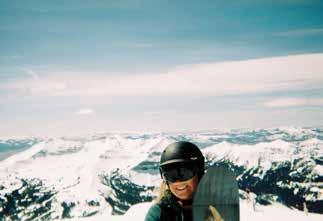
Explore Big Sky 23 November 17-30, 2022
FORMER BIG SKY RESIDENT DIRECTS, PRODUCES ALL-FEMALE SKI FILM “NEXUS” COMES TO BOZEMAN DEC. 2 AT BOMB SNOW FILM FESTIVAL SPORTS
Shannon Corsi on Lone Peak in the winter of 2018-19. PHOTO COURTESY OF SHANNON CORSI
Dingle says she didn’t have a car during her time at MSU so she skied wherever her friends went. She had fun with her ski pass photos on more than one occasion. PHOTO COURTESY OF SASHA DINGLE
Corsi and her friends celebrate Big Sky Resort’s closing day 2019 by building a kicker in Beehive Basin. PHOTO COURTESY OF SHANNON CORSI
NEW SNOWBOARDING SHORT FILM SHIFTS FOCUS AWAY FROM ATHLETES TO THE RUGGED LANDSCAPES THEY ADVENTURE IN
DIRECTED BY RAFAEL PEASE, IS NARRATED IN SPANISH WITH ENGLISH SUBTITLES AND PREMIERED IN BOZEMAN
BY JULIA BARTON
BOZEMAN—In his latest short film, director and athlete Rafael Pease opted out of the traditional structure of ski and snowboard movies by situating the mountains as the main focus rather than the people exploring them.
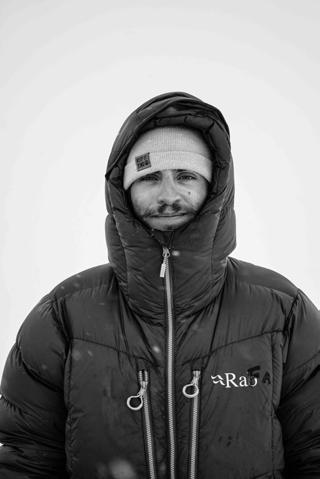
“SOMOS” is narrated by remote Alaskan mountains, and in this story, the mountains speak Spanish.
While Pease intends to make “SOMOS” available for free streaming later down the line, the film debuted at the Rialto in Bozeman on Nov. 9.
Pease, a Chilean-Cuban athlete, filmmaker and activist, has been making films since 2015 as an outlet for sharing environmental information with the public. For this project, Pease wanted the mountains to do the talking.
Although the film features Pease and Argentinian snowboarder Inaki Odriozola mountaineering and riding, Pease said: “We're not protagonists. We're just figures in it… it's [from] the perspective of nature and how she views us.”
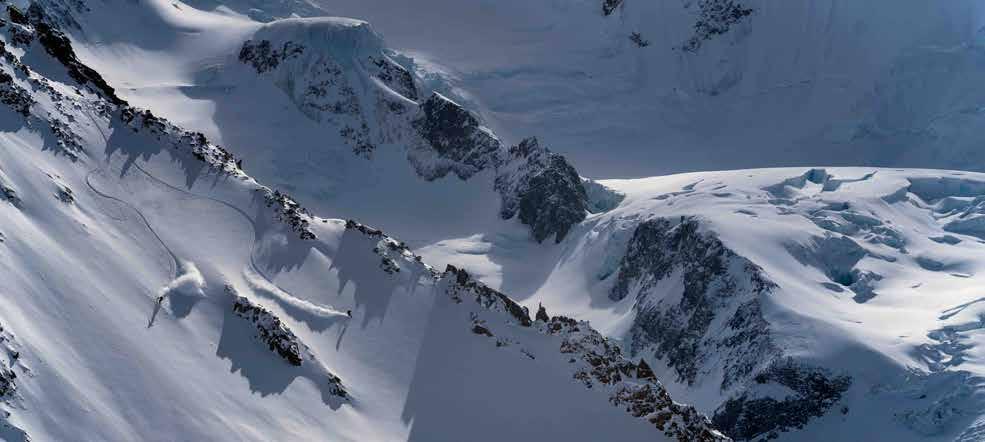
Viewers of ski and snowboard films are used to seeing impressive, beautiful, snow-covered landscapes, but the narratives are too often framed as athletes conquering the mountains rather than learning to live harmoniously with them. The term “somos” in Spanish translates to “we are.”
Pease hopes that through viewing his films, people will be inspired to take action to protect mountains instead of continuing to conquer them.
“You can love things to death, and if you don't know what your impacts are—or what the impacts of bigger industries are—on the environment, then you're just going to be complacent,” Pease said.
Through making the film’s narration in Spanish, Pease paid homage to his roots while also working to make the film more accessible to Hispanic audiences.
“I feel like all the ski and snowboard movies I've seen come out of the states, that people from all around the world watch, are all in English and it's all predominantly Americans in the films who look and speak the same,” Pease said.
While reading subtitles during a ski film isn’t exactly what English-speakers in America often expect, “SOMOS” offers a new experience and creates visibility for the mountains, Spanishspeaking populations and non-American athletes.
In the coming months, Pease intends to have the subtitles translated into many different languages and make the film easily accessible digitally across the world.
“My goal with all the films I have made is to have the largest visibility possible,” Pease said. “If we hold the position of being a journalist or a filmmaker, or whatever it is, then we must do it right.”
Explore Big Sky 24 November 17-30 , 2022
“SOMOS,”
Landscape: Rafael Pease and Iñaki Odriozola link turns down a steep, crisp mountain face. PHOTO BY JESSE LEVINE / CONNECTIONS MOVEMENT
A&E ARTS & ENTERTAINMENT
Portrait: Rafael Pease splits his time between Alaska and Chile, chasing the winter and spring seasons between hemispheres.
PHOTO BY JANA ROGERS / CONNECTIONS MOVEMENT
THURSDAY, NOVEMBER 17
Mosaic Art Class BASE, 10 a.m.
After School ARTventure BASE, 4:30 p.m.
Open Pottery Studio BASE, 6 p.m.
Screening: Thursday Night Football
The Independent, 6 p.m.
Live Music: Chandler Huntley Montage Big Sky Alpenglow Lounge, 7 p.m.
AA Meeting Big Sky Chapel, 8 p.m.
FRIDAY, NOV. 18
Story Time for Toddlers BASE, 10:30 a.m.
Help With Healthcare Insurance Enrollment
Big Sky Community Food Bank, 11 a.m.
Live Music: Cole Decker Montage Big Sky Alpenglow Lounge, 7 p.m.
Live Music: DJ Take a Chance and Weston Lewis Tips Up, 9 p.m.
SATURDAY, NOV. 19
AA Meeting Big Sky Chapel, 7:30 a.m.
St. Joseph’s Mass Big Sky Chapel, 5 p.m.
Bozeman Symphony: Current Commotion-Seven Pillars The ELM, 6:30 p.m.
Live Music: Amanda Stewart Montage Big Sky Alpenglow Lounge, 7 p.m.
Live Music: W.C. Huntley The Independent, 8 p.m.
Live Music: DJ Swamp Moose Tips Up, 9 p.m.
SUNDAY, NOV. 20
St. Joseph’s Mass Big Sky Chapel, 8 a.m.
All Saints Big Sky Service Big Sky Chapel, 10 a.m.
Big Sky Christian Fellowship Service
Big Sky Chapel, 4:30 p.m.
MONDAY, NOV. 21
Fourth Annual Friendsgiving The Wilson Hotel, 4 p.m.
Screening: Monday Night Football
The Independent, 6 p.m.
Live Music: Amanda Stewart
Montage Big Sky Alpenglow Lounge, 7 p.m.
Trivia
Tips Up, 9 p.m.
TUESDAY, NOV. 22
November Specialty Class: Qigong with Sofia Santosha Wellness Center, 12 p.m.
Screening: BURIED: The 1982 Alpine Meadows Avalanche Documentary Independent, 5:30 p.m.
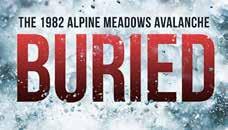
WEDNESDAY, NOV. 23
Big Sky Fire District Board of Trustees Meeting
Big Sky Water & Sewer District, 8:30 a.m.
St. Joseph’s Mass
Big Sky Chapel, 12 p.m.
AA Meeting
Big Sky Chapel, 12 p.m.
Trivia The Independent, 7 p.m.
THURSDAY, NOV. 24
Big Sky Resort Opening Day Big Sky Resort, 9 a.m.
Thanksgiving Day Football Watch Party
Beartooth Pub and Rec, Montage Big Sky, 10 a.m-10 p.m.
Three Course Thanksgiving Day Dinner
Montage Big Sky Cortina 12 p.m.
Family Portraits Montage Big Sky Living Room p.m.
Local Cider Tasting Montage Big Sky Alpenglow Lounge, 3 p.m.
World Cup Watch Party-Tacos & Tequila
Montage Big Sky Rivalry Room, 12 p.m.
Al-Anon Meeting
Big Sky Chapel, 4 p.m.
Screening: Thursday Night Football
The Independent, 6 p.m.
Live Music: Chandler Huntley Montage Big Sky Alpenglow Lounge, 7 p.m.
AA Meeting
Big Sky Chapel, 8 p.m.
FRIDAY, NOV. 25
Live Music: Marcedees Carol Montage Big Sky Alpenglow Lounge, 7 p.m.
Live Music: Ticket Sauce Tips Up, 9 p.m.
SATURDAY, NOV. 26
AA Meeting
Big Sky Chapel, 7:30 a.m.
Shop Small in Big Sky on Small Business Saturday Big Sky, All Day
St. Joseph’s Mass Big Sky Chapel, 5 p.m.
Live Music: Amanda Stewart Montage Big Sky Alpenglow Lounge, 7 p.m.
Live Music: DJ Moe Jazz Tips Up, 9 p.m.
SUNDAY, NOV. 27
St. Joseph’s Mass Big Sky Chapel, 8 a.m.
All Saints Big Sky Service Big Sky Chapel, 10 a.m.
Big Sky Christian Fellowship Service
Big Sky Chapel, 4:30 p.m.
Woodburnt Ornaments with Katherine Berceau BASE, 6 p.m.
MONDAY, NOV. 28
Story Time for Toddlers BASE, 10:30 a.m.
Screening: Monday Night Football
The Independent, 6 p.m.
Draw Your Own Pet Portrait with Megan Buecking BASE, 6-8 p.m.
TUESDAY, NOV. 29
Big Sky Collaborative Coat Drive Begins, Through 12/13 Big Sky Community Food Bank & Various Drop-off Locations
November Specialty ClassQigong with Sofia
Santosha Wellness Center, 12-1 p.m.
Art Studio Practice BASE, 1-4 p.m.
WEDNESDAY, NOV. 30
St. Joseph’s Mass Big Sky Chapel, 12 p.m.
Godly Play: Afterschool Program Big Sky Chapel, 4-5:30
Sgraffito Clay Mugs with Katherine Berceau BASE, 6-8 p.m.
ABC’s of Neurological & Behavioral Concerns in Childhood
Big Sky Library, 6:30-8 p.m.
Trivia
The Independent, 7 p.m.
A more detailed version of this calendar is updated weekly on explorebigsky.com
Explore Big Sky 25 November 17-30, 2022
FEATURED EVENT: BURIED: The 1982 Alpine Meadows Avalanche Documentary Join the Big Sky Behavioral Health Coalition at the Independent to bring avalanche awareness and education to the community, along with information on local resources for trauma recovery. A&E
SKY EVENTS
Thursday, Nov. 17 - Wednesday, Nov. 30 If your event falls between Dec. 1 - 14, please submit it to media@theoutlapartners.com by Nov. 23. Do You or Someone You Know Need Help Getting Sober? Contact A.A. - We’re alcoholics helping other alcoholics stay sober. Call 1-833-800-8553 to talk to an A.A. member or Get the Meeting Guide app or Go to aa-montana.org for virtual and face-to-face meeting times and locations
BIG
CALENDAR
MAKING IT IN BIG SKY: KNAUB & COMPANY
BY MIRA BRODY
BIG SKY—If there’s anyone who has seen the Big Sky community grow, it’s the Knaub family. JC arrived the year construction started at Big Sky Resort and he and his wife, Marjorie, built their life and business around the people of the area, raising children Jeff and Kristi and managing Knaub & Company and their team of tax and bookkeeping experts.
Explore Big Sky sat down with Marjorie to talk a little bit about the history of their business, their family’s deep roots, and introduce us to each of their team members: Samantha Honatke, Jessica Trulen and Norla Grimm.


This series is part of a paid partnership with the Big Sky Chamber of Commerce. The following answers have been edited for brevity.
Explore Big Sky: I’d like to start with a little background information on you, what’s your family’s history in the Big Sky area?
Marjorie Knaub: I married JC Knaub in Big Sky in 1980 after a six-year courtship. JC came to Big Sky in 1973 when they were first building the resort. We bought 4 acres along the South Fork of the West Fork of the Gallatin River in 1980 and built our home in 1983. We raised two children (Jeff and Kristi) who were ski racers involved in Big Sky Ski Education Foundation. [Kristi] now owns Maverick Mountain Ski Area with her husband, as well as Elkhorn Hot Springs, and is a K-8 teacher in a one-room schoolhouse in Polaris, MT. Jeff works in the family construction business (Andesite Construction) in Big Sky and was married in 2020. They are building a house near Hebgen Lake, since Big Sky is not an affordable place to live.
Samantha and her husband, Mike were long-time Big Sky residents, but moved to the Four Corners area in 2014 in order to buy a house. They have a 5-year-old son. Jessica has lived in Big Sky since 2002. She is raising twin boys with her husband, Jeff, who works in the residential construction industry. Norla is a longtime resident of Big Sky and also operates her own bookkeeping practice.
EBS: Tell me about the history of Knaub & Company; when did it start? How has it grown over the years?
MK: I graduated from Montana State University in 1978 and worked for a national accounting firm in Billings before moving to Bozeman in 1981 to work for a local CPA firm. After 13 years with that company, I decided to strike out on my own with another partner to form Knaub & Company in 1994. After commuting
from Big Sky to Bozeman for over 20 years, I moved the office to Big Sky in December of 2005.
EBS: How big is your team?
MK: I employ Samantha Honatke and Jessica Trulen fulltime, and Norla Grimm works part-time. We have had numerous staff over the years work part-time during tax season. Our success is due to our loyal employees. Samantha and Norla have been with the firm since 2011 and Jessica started in 2015. I plan to retire in 2026, at which time Samantha will take over ownership of the firm. We are a family and dog-friendly company. Family comes first, and dogs are welcome in the office.
EBS: Tell me about the different services offered at Knaub & Company.
MK: Knaub & Company specializes in individual and small business income tax planning and preparation. We offer bookkeeping and payroll services, as well as QuickBooks training and support. We also do bookkeeping and consultation with Homeowners’ Associations.
EBS: Your family has been here for quite some time, what are some changes you’ve seen over the years—but also, what are some things that never change.
MK: We have seen a lot of change over the years. There was no high school when our kids were in school, so they had to be bussed to Bozeman. There are a lot of positive changes in terms of services—we now have a hospital, dental and vision services, grocery stores, a movie theater and numerous restaurants to choose from. The negative
– Marjorie Knaub, owner, Knaub & Company
side has been the traffic. We have to plan our driving around the peak traffic times.
EBS: What is the best part of working in the Big Sky area?
MK: Big Sky is a gorgeous place to live. Our two dogs are in heaven being free to roam on our 4 acres. The outdoor activity options are amazing.
EBS: What is the best business advice you have ever received?
MK: Treat your clients with respect. Return phone calls promptly and answer emails timely.
EBS: Is there anything else that you want to tell the Big Sky Community?
MK: We appreciate all of our loyal clients and enjoy working with local businesses and individuals. The dynamics have changed somewhat due to COVID, but we have adapted along with everyone else
Explore Big Sky 26 November 17-30, 2022
BUSINESS
Marjorie Knaub and her team at Knaub & Company: Samantha Honatke, Jessica Trulen and Norla Grimm. PHOTO COURTESY OF KAUB AND COMPANY
”
We appreciate all of our loyal clients and enjoy working with local businesses and individuals. replace
“
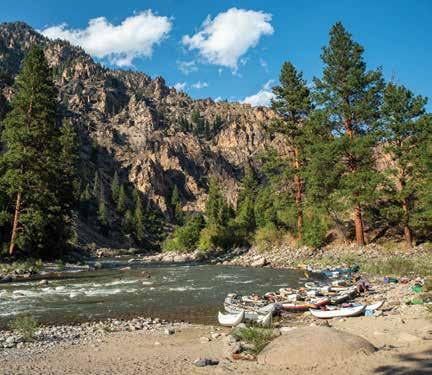



LLIMITED AVAILABILITY FOR SUMMER 2023 CONTACT US TODAY TO LEARN ABOUT OUR EXCLUSIVE WHITE WATER RAFTING AND FISHING EXPERIENCES ON THE MIDDLE FORK OF THE SALMON RIVER IN IDAHO RESERVE NOW AT BOUNDARYEXPEDITIONS.COM OR (888) 948-4337
OPINION
I have noticed a trend of parents calling out other people’s kids on social media for doing something wrong. I know we can’t just let kids get away with everything, but the use of social media to shame a child doesn’t seem like it would be effective. Is this the new norm or am I justified in feeling like this is the wrong way to handle a situation?
Sincerely, Village Mother
The other day, one of the young elk calves that hangs out in front of my burrow was bugling pretty loudly and being a nuisance. I’m pretty grumpy (all badgers are), so I waddled over to tell it to stop. As I approached, the older elk scattered. They left this loud little guy all by himself with me, a pretty vicious creature to be honest. I just hissed and it ran away in the direction of the herd. Adult elk are weird. They will abandon a baby elk if they think they are in danger. Every elk for themselves.
From what I know of humans, they don’t leave their little humans when they are in trouble. They stay there and protect them. They bring their herd around and make sure the little human is safe. Big
Sky is a small town and I think that the best thing about it is that everyone knows each other (that’s how they find out about where my cete of badgers hang out). That elk mother who left her kid to bugle loudly on his own is a lot like the human posting videos on social media.
The calves behaving badly shouldn’t be left to fend for themselves. They should have a herd sticking around to snort and make sure they stop making bad choices. If you just leave a young one out there exposed to the elements, who knows what wolf is going to come along and hurt them?
I would remind humans who post these things that we are lucky to live in a place where other parents step in and help out little humans—who aren’t even
their own—when it comes to bad decision making. It takes a village, or a cete in my case, to raise good little humans.
I’m about to take a 29-hour nap after eating a marmot, Badger
Tired of bad advice from other humans? Woodland creatures have been giving each other unbiased advice for years so we’ve hired a wise local badger to help you navigate life’s toughest trails. Badger will select one or two anonymous questions a week to answer! Check the latest issue to see if badger thinks your question is worth digging into. Digging is what badgers do best! Send your questions to badger@theoutlawpartners.com or anonymously at: tinyurl.com/3vkrjdau.
Explore Big Sky 28 November 17-30, 2022
Dear Village Mother,





NATURAL. SUSTAINABLE. HEALTHY. EXPLORE MEMBERSHIPS AT REGENMARKET.COM FARM FRESH FOOD, DELIVERED TO YOUR DOOR. ScantoOrderOnline
BY DR. KALEY BURNS EBS COLUMNIST
Amazon is the first destination for many online shoppers looking to buy pretty much anything, including health and wellness products. Shopping for some products on Amazon can be advantageous, but here we discuss some of the main reasons why dietary supplements should not be bought from Amazon. Amazon sells almost everything and anything, but what do they know about health and nutrition? They don’t do much to verify the authenticity of the manufacturers, supplements, labels, descriptions, etc. Their job is just to sell and fulfill.
Someone could be making sugar pills and selling them as a medical cure. Many people would be appalled if they knew how prevalent counterfeit dietary supplements are. Sadly, fake vitamins and “health” capsules have made their way into the general consumer market via avenues such as Amazon. This is largely due to the fact that there is no overseeing scrutiny to determine which supplements are allowed to be sold and which are not. Additionally, a doctor- designed protocol is optimal, especially when you’re facing specific health concerns.
Then comes the concern regarding expired products being sold on markets such as Amazon. Another way these are being sold is, taking a product that
has expired, changing the dates on the package labels, and voila: a cheap “new” product comes back to the market. Many of the sellers on Amazon are individuals, not companies and definitely not trained medical professionals.
Big box stores such as Wal-Mart and GNC have repeatedly been caught selling supplements filled with non-labeled ingredients. When someone is taking a supplement, it’s usually to support or promote health, so stick to businesses who are committed to you having a great experience with their company.
The difference between medical-grade and overthe-counter supplements is the ingredients. The OTC vitamins or supplements often use synthetic or cheaper forms of vitamins. Medical grade supplements typically contain the best forms of vitamins that make sure that your body is getting the most effective and natural form of the vitamin. This is why they cost more.
Over-the-counter vitamins generally have lower concentrations of the product. This means that you may need to take more of the over-the-counter supplement to get to the daily goal than that of a medical grade vitamin or supplement. In turn, this negates the lower cost. Moreover, OTC or storegrade supplements have more fillers. This means that you could be ingesting dyes, cork, and much more, as the exact ingredients don’t have to be listed on the label.
In contrast, medical grade supplements are manufactured to the same standards as

pharmaceutical drugs. They are the highest quality supplements available and meet all pharmaceutical standards. The holistic medical team at Big Sky Natural Health can help you to choose the best supplements for your health and current health issues.
BSNH Products
You deserve the highest quality supplements. We are here to bring them to you to help you reach your health goals. An ePedigree is a record, in electronic form, that traces the changes in ownership of a pharmaceutical product. It begins with the manufacturer and documents the transactional history of the product until it reaches the person or organization administering or dispensing it. Although Pedigree laws do not affect natural health and supplement companies, the many benefits to our customers and their patients were too great to ignore. This is why we utilize the only nutraceutical company to implement an electronic track-andtrace program. By utilizing the track-and-trace program, we can ensure our products are authentic and can feel confident that our patients’ well-being is protected.
Dr. Kaley Burns is the founder, owner and naturopathic doctor at Big Sky Natural Health. She embraces a natural approach to health and aims to similarly inspire and guide others on their health journey. Dr. Burns has advanced training application of regenerative and intravenous injection therapy. She also serves as the vice president and CE liaison of the Montana Association of Naturopathic Physicians.

Explore Big Sky 30 November 17-30, 2022
recommended products available
BUZZ DOCTOR RECOMMENDED VERSUS AMAZON REVIEWED SUPPLEMENTS RAISING THE STANDARD OF CARE OPINION
Doctor
at Big Sky Natural Health. PHOTO BY KALEY BURNS HEALTH
LOCAL KNOWLEDGE
BY PAUL SWENSON EBS COLUMNIST
Mr. Lichen goes into a bar and orders a drink.
The bartender says, “We don’t serve your type here.”
Lichen responds, “How come? I’m mostly a ‘fun guy’.”
This of course is a hilarious joke for a mycologist, one who studies fungi, or a lichenologist.
Once you’re done wiping away tears of laughter, I’d like to introduce you to a class of composite organisms that live everywhere in the world and add a lot of interesting texture and color to our region. You’ve all seen them but maybe not known what they are.
Of course the big question is, “How do lichens reproduce, since they are actually not an individual organism?” The answer is very interesting. Most fungi reproduce asexually by producing spores broadcast into the wind that settle onto surfaces away from the parent fungus and will grow if conditions are right. But the fungi involved in lichens cannot survive without the algae, bacteria, and yeast that it harbors. Therefore, the fungi in lichens have evolved a process where they bundle together their spores along with algae cells, bacteria, and yeast, into little packets called soredium which are then dispersed into the air.
of lichen as a time measuring device is called lichenometry. But how slow do they grow?


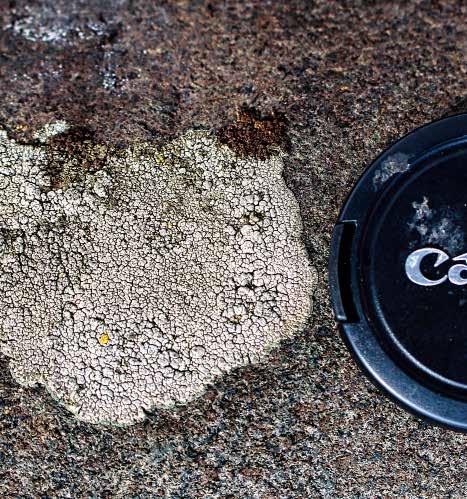
In the alpine environment of Big Sky, crustose lichen like the one in the photograph grow about 0.5mm in diameter per year. So the one shown in the bottom most photo is about 140 years old (7cm = 70mm => 70mm/0.5mm/ year = 140 years); 2022-140 = 1882 is when this organism started growing. That was before Montana was a state!
Some species in the high alpine and Arctic have been dated into the thousands of years, making them some of the oldest organisms in the world. So when you’re scrambling around on the rocks in our region you might see some lichens that have been around longer than most of recorded human history. Thus one should respect that they have not been disturbed for this immense amount of time and leave the rocks untouched.
There are multiple classifications on the shape and structure of lichen: Crustose, Foliose, and Fruticose. Crustose are the ones you see growing on rocks in our region. As the name implies, they

Lichens are not a single type of organism, but a mutualistic partnership between fungi, algae, cyanobacteria, and in some cases yeasts. Mutualism is defined in biology as a relationship between two or more organisms where their growth together benefits each organism. In the case of lichens, the fungus provides the structure where the algae, cyanobacteria, yeast, or any combination of them, can grow protected from the environment, including shielding from dehydration, predators, disease, ultraviolet radiation, temperature extremes, and other potential threats.
The fungus also anchors itself to a growing substrate such as a rock, tree, or building, giving the other members of this living community a stable platform. The algae and bacteria grow in between strands of fungal hyphae where they perform photosynthesis producing carbohydrates that they need for growth. These carbs are also provided to the fungus for its growth. It’s like a little micro-economy where the algae and cyanobacteria pay sugar rent to the fungus in exchange for a place to grow and thrive.
One of the major phyla of fungi that produce lichens are the Ascomycetes, or cup fungi. If you zoom into the first photograph you will notice the cup-like structure of the fungus.
If the soredia land on a suitable surface, the fungus begins to grow its structure, and the algae, bacteria, and yeast begin their growth within this thallus. Depending on the species, this growth can be exceedingly slow. Lichen grows so slowly, in fact, that they are used to date ancient buildings and structures by archeologists, age of glaciers by glaciologists, landslides and other land deformation by geomorphologists. This use
look just like crusts on the rock without much, if any, vertical structure. All the lichens pictured in figures 1 and 3 are crustose. Foliose lichens look like they are producing leaves, but of course that is the fungus thallus. Fruticose are long, fibrous, wispy lichens most people call “moss” that grows on trees.
These fruticose lichens grow much faster than the crustose lichens so are not used in lichenometry.

Lichens come in all sorts of colors, textures, shapes, and sizes and add interest to the landscape. Look for lichen when you travel out and about in the Big Sky region. Hopefully you’ll recognize these amazing living communities that have been around for millennia and will give them a nod for their hardiness.
Paul Swenson has been living in and around the Big Sky area since 1966. He is a retired science teacher, fishing guide, Yellowstone guide and naturalist. Also an artist and photographer, Swenson focuses on the intricacies found in nature.
Explore Big Sky 31 November 17-30 , 2022 OPINION
Four inches of rock showing six different species of lichen, and at least 20 individual colonies of the orange lichen.
PHOTO BY PAUL SWENSON
Ascomycetes fungus showing the “cup” structure in a lichen. PHOTO BY PAUL SWENSON
Crustose lichen whose diameter is about 7 centimeters. PHOTO BY PAUL SWENSON
Fruticose lichen on a Douglas fir twig. PHOTO BY PAUL SWENSON
ARE YOU LICHEN (LI • K N) IT?





SKI TIPS WITH DAN EGAN ALL
TERRAIN SKIING
BY DAN EGAN EBS CONTRIBUTOR
It’s amazing to think about releasing my first book, “All-Terrain Skiing,” in 1996, as the world was very different then in both technology and in sport. It was more than a book: it was an interactive program with VHS video, weatherproof flash cards… and the book. And now I’ve updated the program and recently released “All Terrain Skiing Vol. II,” complete with the ATS app and videos on my YouTube channel.
Today, with the new wider, shaped skis, we can glide right over the snow. In the straight-ski days, we plowed through the snow and needed a lot of momentum to turn the skis. What I see with the current day equipment is how skiers rely too much on the skis to do the work, and not enough on their body mechanics. This results in fatigue and lack of balance.
The solution is provided in my All-Terrain Skiing II (ATS II) program, which include many of the skills and drills found originally in “AllTerrain Skiing,” plus new ones that enhance body movements in the new world of ski equipment. These body mechanics make skiers more efficient when they encounter changes in speed, terrain, conditions, and situations.
The All-Terrain Skiing II program is organized into five categories: Balance, Upper Body, Power, Fluidity and Agility, with individual drills described in each. These drills help you make body alignments while in motion, which ultimately increases your efficiency of motion and allows you to ski longer and with more control.
Skiing is not an intellectual activity; skiing is a simple physical activity based on good body position. The goal of this program is for you to become aware of every aspect of your body positioning to expand where and how you ski the mountain. The drills are designed to take your mind off performance and focus your body energy on the task at hand. By removing the projected outcome, we can zero in on how to react in each moment to the changing situations, terrain, and conditions. This will enhance our performance overall.
The program begins with Balance then progresses to Upper Body, Power, Fluidity and Agility. Each section has a series of drills which complements every other drill and builds competence. Even if some of the drills seem silly or simple at first, as you practice, you’ll see how they progressively build, as will your confidence and the courage to try highend maneuvers outlined in the program.
There are lots of “skiing gurus” and professional ski instructors who have developed specific teaching techniques to help skiers improve. Some will tell you carving is the ultimate skill. Others will say that edge angle matters. And still others focus on knees, hips, and hands. I’ll introduce you to a wide range of body motions and skills that simply ask you to be calm and strong, fluid and loose. Learning to do this will increase your balance moving downhill over varying terrain.
My goal is to help skiers improve by concentrating first and primarily on their mental state and body:

Mind. Most skiers don’t understand the importance of being mentally prepared, as well as physically in shape, to ski. I begin with an understanding of the human mind and body, exploring desire, confidence, and will power.
Body. I’m always amazed to see skiers who wake up, drink a cup of coffee, then head up the slopes and wonder why they have burning thighs by 10 a.m.
Here, we focus on breathing to provide the oxygen muscles need to perform well.
Equipment. With today’s equipment, confusion can arise when shopping for the right boots, ski length and ski width, and other selling features.
Conditions. One thing is certain—the skier will always encounter changing terrain and conditions. The All-Terrain Skiing II program teaches the progressive skiing skills needed for everything from groomed trails to deep powder.

All-Terrain Skiing II is an integrated, selfcontained program for beginning, intermediate, and advanced skiers—in other words, anyone who wants to learn to ski better.

In my Ski Tips columns this year I write and share on the topics, skills and drills out lined in AllTerrain Skiing II program to help expand your on snow experience this winter.
Extreme skiing pioneer Dan Egan coaches and guides at Big Sky Resort during the winter. His 2022-23 steeps camps at Big Sky Resort run Dec. 17-18, Jan 11-13, March 1-3, and March 8-10. His book, “Thirty Years in a White Haze,” was released 2021 and his newest book, “All-Terrain Skiing,” was released Nov. 5, 2022. His books and worldwide ski camps are available at www.Dan-Egan.com
Explore Big Sky 33 November 17-30 , 2022 OPINION
Dan Egan drops in at Big Sky for his camps this season. COURTESY OF WARREN MILLER ENTERTAINMENT
Dan Egan Skiing the steep and deep at Big Sky. COURTESY OF WARREN MILLER ENTERTAINMENT












EVERY DROP COUNTS
A COMMUNITY’S CONNECTION TO THE WATERSHED
BY MARNE HAYES EBS CONTRIBUTOR

What do we actually know about how we are connected to our watershed? How does the connection between precipitation, absorption, runoff, evaporation and consumption play out through our daily use of water, whether for personal or commercial use, recreation, irrigation, or otherwise?
At the most basic level, a watershed encompasses all the land surface that collects and drains water down to a single exit point. Think mountains, to streams, to rivers. The perpetual cycle of water flowing over and through land surfaces eventually sculpts all landscapes into distinct entities known as watersheds, basins, or drainages.
Everyone lives in a watershed somewhere. All of the ways we use water in our daily lives for work or play, home or community, occurs in and affects a watershed. Watersheds can be as large as the Mississippi basin, or they can be as small as all the spaces in a community like Big Sky where contributions to water flows come from our yards, roofs, driveways, or streets to storm drains and out to tributaries.
The Gallatin River watershed has 23 major streams that total nearly 400 miles—394 to be exact. All of these streams, or tributaries, make up the Gallatin River’s watershed. The West Gallatin starts in Yellowstone and flows northeast along U.S. Highway 191. The East Gallatin forms in the Gallatin and Bridger mountains then flows through Bozeman and Belgrade. The West and East sections of the Gallatin merge near Manhattan, forming the Gallatin River proper. All pieces of the Gallatin, all connected, flowing from different sources to one source—and all connected to the communities through which they flow.
Our watershed health depends on the collaborative nature of how we use, reuse, share, access, and maintain our water sources. Part of the nature of preserving community water is through intentional reuse and conservation. Because a watershed only receives water as snowfall, rainfall, and other airborne precipitation like fog or humidity, conservation is critical in slowing the extractive nature of how we use our water: slow the water down, spread it out, give it more opportunity to be absorbed into the ground and stored in the aquifer. In other words: conserve it.
The more we can do to capture, reuse, restore and conserve our water sources, the better for the watershed. Some of these solutions are small and require only minimal changes to our daily uses. Some are bigger and more complex, requiring
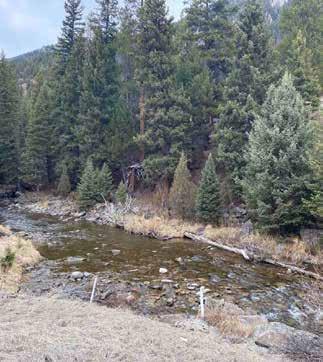
WRITERS ON THE RANGE
THE FADING MIRACLE OF MIGRATION
BY PEPPER TRAIL WRITERS ON THE RANGE CONTRIBUTOR
For the past few weeks, dozens of turkey vultures have been circling on thermals over my house in Oregon, preparing to soar away south into California. Not long ago, I saw a late monarch butterfly passing high overhead, its orange wings incandescent against the blue sky.
These are examples of the great migratory movements that enliven the West every spring and fall.
The long-distance migrations of seemingly fragile monarch butterflies are among nature’s most incredible phenomena, with eastern populations wintering in vast numbers in a tiny refuge in Mexico, and western populations at a few sheltered spots along the California coast.
Migration is central to the lives of many wild animals of great public interest and huge economic importance, from salmon to waterfowl to large mammals like pronghorn and elk. Just about everybody attuned to the natural world looks forward to some migratory milestone, whether it’s the arrival of the first robin of spring or the beginning of duck hunting season.
Thanks to advances in technology and data collection, this is a golden age for research on migration. Radar allows documentation of the magnitude of animals on the move: On a recent night, for example, it was estimated that 5.4 million birds were in the skies over Oregon.
The citizen science database eBird, combined with advances enabling the detection of signals from lightweight tags attached to migrating animals, have provided migration maps of stunning specificity.
At the same time, we are also coming to understand the many threats to migration. The drastic declines of Pacific salmon are known all too well. Elk and pronghorn face ever-increasing obstacles posed by highways, roads to access and extract fossil fuels and other developments on the landscape.
But what’s happening to migratory birds really tells the story. Based on many lines of evidence, scientists have concluded that 2.9 billion — yes, billion — breeding adult birds have been lost in the United States since the 1970s. That is one-third of the total bird population of the United States.
Of that 2.9 billion, 86%, 2.5 billion, are migratory species. Although declines of birds in the western part of the country are less severe overall than in the East, many of our familiar migrants are showing dramatic reductions, including rufous hummingbird, down 60%, common nighthawk, 58%, band-tailed pigeon, 57%, Lewis’s woodpecker, 67% and evening grosbeak, 92%.
Why is this happening?
The loss of habitat is the main problem for many species, especially grassland birds. For example, between 2018–19 alone, 2.6 million acres of grassland in the Great Plains were converted to row-crop agriculture. That’s an area larger than Yellowstone National Park. Loss of winter habitat in Mexico and Central America also threatens many species.
Human constructions from power lines to wind turbines to oil pits increase the dangers of migration for birds. The greatest hazard may seem mundane, but it’s ubiquitous: windows. Collisions with windows are
systemic changes, with broader and more mindful community and global participation. Our job as the community Task Force is to make sure we are using the best sources to help us mindfully address the issues facing the Gallatin River watershed, knowing that our community, and others, depend on it.
estimated to kill a staggering billion birds in this country each year. Brightly lit skyscrapers are also a menace to songbirds, most migrating at night.
Climate change adds to the threats for migratory species. In addition to broad effects like widespread drought in the West and melting permafrost in the Arctic, climate change can scramble the relationship between migration timing and the availability of food resources. Hungry migrants may arrive in spring to find that the peak of insect abundance has already passed.
Fortunately, there are many things each of us can do to help migrating birds.
First, advocate for the preservation of bird habitats –and provide your own by planting native fruiting and flowering plants on your land.
Second, take steps to reduce bird collisions with your windows. Many solutions are available, including “Zen wind curtains”: light cords hanging in front of the glass. And keep your cats inside, as free-ranging cats take a staggering toll on birds.
Finally, support organizations that advocate for birds and their habitats or promote research on migratory birds, such as the National Audubon Society, the American Bird Conservancy, and the Cornell Laboratory of Ornithology.
Together, we can save the lives of millions of birds, and help ensure that their incredible migratory journeys never end.
Pepper Trail is a contributor to Writers on the Range, writersontherange.org, an independent nonprofit dedicated to spurring lively conversation about the West. He is a naturalist and writer in Oregon.

Explore Big Sky 35 November 17-30 , 2022 OPINION
Marne Hayes is the communications manager for the Gallatin River Task Force.
The West Fork of the Gallatin River downstream from the Big Sky County Water and Sewer District storage ponds. PHOTO BY BELLA BUTLER
A LA CARTE
BARTENDING IS ABOUT ‘THE EXPERIENCE’ FOR THE INDEPENDENT’S LOWENSTEIN
 BY RACHEL HERGETT EBS CONTRIBUTOR
BY RACHEL HERGETT EBS CONTRIBUTOR
I snagged the last seat at the lobby bar at The Independent on a Wednesday night. It’s shoulder season, but the promise of a couple rounds of pub trivia drew in the locals.
The Indy is a movie theater and lounge that also features additional dining and drinking options on the patio and upstairs at Perch. There’s an amusing menu of craft cocktails in the lobby bar that takes inspiration from movies. One is the “Godzilla,” a gin and pear brandy-based cocktail served with a plastic dinosaur perched on the rim of the glass.
But I’m here to talk to bartender Zach Lowenstein, and ordering off the menu isn’t very telling. Lowenstein suggests a daiquiri. It helps him begin to learn customer tastes. It’s also a test for bartenders: Simple, with three ingredients, but not easy to balance.
I decline. Rum isn’t that exciting to me. I prefer whiskey or tequila, I say.
“Tequila” seems to be a magic word for Lowenstein, who immediately starts lining up a set of bottles and tasting glasses in front of me.
Lowenstein was born and raised in San Jose, California, before making his way to Orange County. He’s attractive to the point both coworkers and customers rib him for it, sporting a boyish grin and facial hair straddling the line of scruff and beard in a way that only seems to enhance his stark jawline. He is long and lean and I wonder if he’s a climber. A swimmer, he tells me, specializing in freestyle sprints.
In a way, the sport led him to bartending. Lowenstein is a talker, admittedly and obviously, and his swim coach at Golden West College in Huntington Beach recognized that as a skill in the world of customer service. As a bartender,
Lowenstein said his goal is to get to know the people he serves, and he hopes they will get to know him as well.
By 21, Lowenstein was working at Hotel Joaquin in Laguna Beach and deepening a love of tequila behind the bar. His interest in the agave-based spirit connected him to an industry trip to learn more about the distillation and bottling process.
On Wednesday, Lowenstein gets excited talking about riding motorcycles through the agave fields in Jalisco shared by Don Fulano and Fortaleza on the trip, and shows me a picture of a tattoo he has on his upper arm featuring a skull crowned with flowers and an agave rosette reminiscent of the hand-painted version on the top of Fortaleza bottles. He tells me that the best tequilas will be 100% agave with no additives, and adds a taster of Don Julio’s 1942 to the end of the line for comparison. The caramel-color additives give the 1942 a bit of sweetness, and after the more peppery depths of the others, I taste Lowenstein’s point.
Lowenstein has been in Big Sky for three years,

Duke is behind the bar shaking drinks on Wednesday as Lowenstein opens a bottle of beer with the lid of a Luxardo cherry jar. They’ve been competing to see who can pop the most bottle caps without a tool specifically made for the purpose. Duke is losing spectacularly.
But it doesn’t seem to matter, and is maybe all part of the show. Sometimes, Lowenstein said, asking “What do you want?” of a customer isn’t enough. And I understand why he poured me a tequila flight: He knew I would enjoy it.
Rachel Hergett is a foodie and cook from Montana. She is arts editor emeritus at the Bozeman Daily Chronicle and has written for publications such as Food Network Magazine and Montana Quarterly. Rachel is also the host of the Magic Monday Show on KGLT-FM and teaches at Montana State University.

Explore Big Sky 36 November 17-30 , 2022 OPINION
following general manager Ruth White from Hotel Joaquin to Lone Mountain Ranch. When White was opening The Independent, she knew she wanted Lowenstein and Michael Duke to run the bars.
Lowenstein jokes and talks with customers during trivia night in shoulder season. PHOTO BY RACHEL HERGETT
Cups of garnishes, including dinosaurs, line the bar at The Independent. PHOTO BY RACHEL HERGETT
























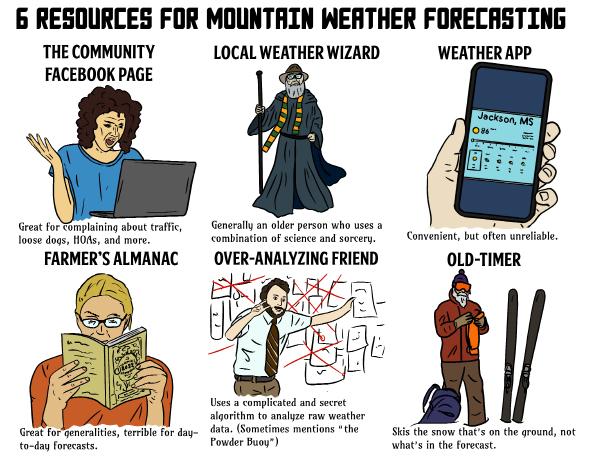

Explore Big Sky 38 November 17-30 , 2022 FUN
ILLUSTRATION BY CY WHITLING
BY JULIA BARTON

Explore Big Sky 39 November 17-30 , 2022 FUN
SKY BEATS
NON-PROBLEMATIC THANKSGIVING
BIG
A
The winter holiday season has officially begun which means that families will be sitting around the table together, enjoying homemade food, tasty beverages and, thanks to Thanksgiving’s proximity to Election Day, likely some not-so-lighthearted political banter. I curated this playlist of non-problematic, jazzy background tunes to emphasize the gratitude of the season and help keep the mood light this Thanksgiving. Enjoy the holidays! 1. “I’ve Got Plenty To Be Thankful” by Bing Crosby 2. “We Are Family - 1995 Remaster” by Sister Sledge 3. “A Charlie Brown Thanksgiving” by Vince Guaraldi Trio 4. “Mashed Potato Time” by Dee Dee Sharp 5. “Apples, Peaches, Pumpkin Pie” by Jay and the Techniques 6. “Thankful” by Kelly Clarkson 7. “Sweet Potato Pie” by Ray Charles and James Taylor 8. “Home Cookin” Jr. Walker & All The Stars 9. “Let’s Turkey Trot” by Little Eva 10. “Gratitude” by Earth, Wind & Fire










BESPOKE LUXURY IN DOWNTOWN BOZEMAN


of luxury residences that emphasize the components of fine
living.
is located
vibrant and historic
neighborhood, only four blocks from downtown and 10 minutes from BZN Yellowstone International Airport Scanhere to learnmore!
Limited number
mountain
Wildlands
in Bozeman's
Northeast
BACK 40
ON LIVING THE DREAM
BY BRIGID MANDER
The life of a professional freeride athlete is full of action, travel and excitement, but it’s no cakewalk getting there. We spoke with four athletes at different points in their careers about how they make it work, and what drives them in skiing and life.

RILEY BECKER, 19
Born in Big Sky, skiing has been woven into life for Riley from the beginning. She got her head start from her ski patrol father who was determined to share his passion with his daughter. He succeeded: Riley’s skills and strength as a freeskier caught the eye of ski photographers and sponsors, and now, as a college student, she’s embarking on the tough but fulfilling path of balancing passion for skiing and life, with figuring out how to make it all work.
On becoming a skier: I was skiing before I can remember. There are definitely photos of me in a backpack as a baby when I went along on backcountry tours! Growing up, the Big Sky Ski Education Foundation had a ski racing and a freeride program. I did a couple freeride comps and I went back to racing, but my dream has always been to be in a Warren Miller movie.
On realizing opportunities in skiing: My friend and I got to go heliskiing in Alaska for our 16th birthdays, and the guides thought I was a pretty good skier. So, I went and asked them what steps I could take to take my freeskiing further. And then I got a sponsorship from them [SEABA Heliskiing]. Last year, I reached out to other sponsors but then COVID happened, so that’s kind of on hold. It took me a while to approach new sponsors because I had thought if they weren’t reaching out, I wasn’t good enough. Finally, I learned that’s not how it works—you have to do all the outreach and work.
Now I’m a freshman at school [at the University of Utah]. This season I want to do some freeride comps, but just for fun, work with photographers I’ve met, and make some film clips. I’d like to do some Freeride World Tour Qualifiers, depending on COVID.
How will you navigate the future?
Even if my ski career does take off, I’m going to keep school at equal importance. I’ve always focused on school and skiing equally, so I’m going to continue my education toward studying law and skiing at the same time. It’s just going to take getting a lot of things done ahead of time.
Right now, I’m studying political science. My plan is to go into environmental law. Perspective-wise,
skiing has completely molded how I think. I grew up outside, and I have a complete appreciation for the environment over other things. [Outside] is home for me.
MCKENNA PETERSON, 33 McKenna Peterson is known as one of the kindest and most modest athletes in freeskiing for good reason, but she’s also one of the toughest and most talented skiers out there. We chatted with Peterson on her return home from the waters of southeast Alaska, where she captains the Atlantis, her 58-foot fishing vessel with her sister Dylan as first mate, from June to September each year. Following in their father’s footsteps, the point is to make plenty of money to ski—and not work—all winter.
On family traditions:
My parents were big skiers. I grew up in Sun Valley skiing, ski raced till freshman year in college, and then paid for school [at the University of Utah] with fishing and bartending. My major was physiology with a minor in nutrition to go into some sort of medical field, but I always knew my life was going to include skiing as a central part.
On fortune and expectations:
I figured I’d be done with [professional] skiing by 30, but it’s the best it’s ever been. I’m making money and I’m having fun, so why not keep rolling with it? But I know I’m not going to do this forever, and there are other things I’d like to experience. Learning to run the [fishing] business, and meeting people who aren’t part of our small resort towns has been great.
On risk and balance in life: (note: McKenna’s father Chris Peterson perished in a 2016 avalanche accident; her two siblings also remain involved in the ski industry and are big mountain skiers.)
It’s a part of skier life, our family accepted the risks. My dad had skied the backcountry for so long and was so experienced and well educated. But seeing that happen has made me more conservative. I furthered my backcountry education and I still have full support of my family. We all still ski.
On standout moments of a full career: A trip I always remember was SheJumps’ Alpine Finishing School in 2011, which really stoked my passion for ski mountaineering. The most fun film I’ve been in was Lynsey Dyer’s Pretty Faces (2014), where I got to be in a movie with all my idols, and it inspired me to try harder to do more filming. Last year I got to film with Matchstick Productions
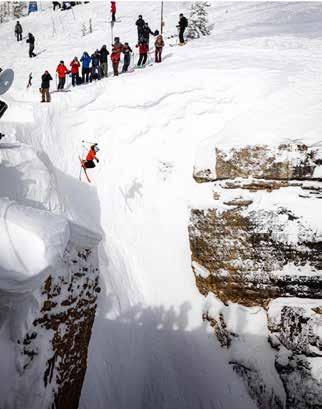
Explore Big Sky 42 November 17-30 , 2022 BACK 40
For Explore Big Sky, the Back 40 is a resource: a place where we can delve into subjects and ask experts to share their knowledge. Here, we highlight stories from our flagship sister publication Mountain Outlaw magazine.
Noun:
wild or rough terrain adjacent to a developed area Origin: shortened form of “back 40 acres”
FOUR SKIERS TALK THE GRIT, THE GRIND AND THE GREATNESS IT TAKES TO RIP WITH THE PROS
Riley Becker catches some air. PHOTO BY WILL WISSMAN
Caite Zeliff airs into Corbet’s Couloir at Jackson Hole Mountain Resort. PHOTO BY CARSON MEYER PHOTOGRAPHY
for Huck Yeah! and that was always a big goal of mine.
What’s next?
This winter I’ll film with Matchstick again, and we’ll keep it local for the most part. I hope to explore zones close to home this winter. After all, I live in Sun Valley for a reason.
CAITE ZELIFF, 26 Passion for skiing isn’t always a direct genetic and lifestyle line. Caite Zeliff was the daughter of a single, non-skiing mother. She did, however, have the fortune to grow up in North Conway, New Hampshire, and go to an elementary school with an affordable lunchtime skiing program. Zeliff found her calling, and sheer determination and athletic talent have brought her opportunities—albeit not the ones she was expecting—to fruition.
On entering the ski world: My elementary school program was my first taste of skiing and the sense of freedom it can provide. A friend eventually told my mom about a ski racing program—I won my first race and got so much confidence from that trophy! I became obsessed with skiing. My goal was to be on the U.S. Ski Team.
On the interference of fate: I then went to UNH [the University of New Hampshire] to ski race Division I, then I blew my knee out. I suddenly just felt relief: I could stop killing myself for racing now. I quit school and moved to Jackson, Wyoming, at 20 just to ski. Ski racing was too much, but I realized with freeskiing I can still work hard as an athlete and have some fun and be creative.
Someone told me I should do the Kings and Queens of Corbet’s [competition]. I’d never skied Corbet’s and didn’t want to do it, but I reached out. My first run was like a flying squirrel in the air; I thought I was gonna die. The next run was smoother, but I didn’t expect to win.
After I won … suddenly I had all these Instagram followers and Warren Miller Entertainment reached out to me. The next year I won that competition again, and I got a call to film with Teton Gravity Research (TGR), and last year I got a full segment in Make Believe.
On making ends meet while skiing all the time: I had gardening jobs in the summers, and slinging food at night at Teton Thai. In the winters, I did the restaurant at night, and ski instructing and coaching during the day. The gardening was the most impactful though—I didn’t have time to be in the gym training while working so many jobs, so manual labor was helpful! I’ve been able to phase out of working so many jobs, and I’m taking skiing really seriously. I try to be transparent about the struggles of “living the dream.” Sometimes ski stars are still slinging drinks!
Winter plans?
This season is going to be weird. But I’m filming again for a segment with TGR! I have a lot under the hood still, and I’m also still figuring out myself as a person and a skier. I make sense of a crazy world by connecting over the outdoors—life makes the most sense there.
ERIKA VIKANDER, 30
As a kid in Montana, Erika Vikander grew up chasing her older brother around Bridger Bowl on snowboards and making the occasional trip to Big Sky. She didn’t know at the time she could make a career out of snowboarding, but once she figured that out it was full steam ahead for this now successful, globe-trotting, full-time athlete.

On taking chances on an unusual dream:
I had a full ride scholarship to play soccer in college but I decided to pursue slopestyle snowboarding. So, I skipped college.
In the last three or four years, I made enough from sponsors to support myself. Before that, I worked in restaurants, coffee shops, construction, retail—you name it, I did it—and also made sacrifices like not
going home for Christmas because I needed all the money for snowboarding.
On twists of fate: One of the worst side jobs was part of a blessing in disguise. I was all set to go to the Sochi Olympics for the U.S. in slopestyle when I blew my knee out. I had no money; I’d spent it all on training. I had to get a job driving an airport shuttle from Breckenridge to Denver, and there I was, loading tourists’ ski bags instead of going to the Olympics. I hated every minute of it. I took a full year off to recover and then someone suggested I try a big mountain competition.
[After a few qualifying competitions] I made it onto the Freeride World Tour (FWT) and I was just like, “Yay, I made it! Just don’t die…!” I mean, I came straight out of the terrain park. At my first big mountain competition, the Subaru Freeride Series in Snowbird, Utah, I even asked another competitor what “fall line” meant … I still feel dumb about that one.
On achieving the dream: I’ve had to be really self-motivated to make it happen on my own. Sometimes I’m gone half the year. Living out of a suitcase sounds romantic and all but it can be really hard too. I’ve also gotten a lot better at balancing my life. I live now in Hood River and Mt. Hood. It’s not the most aggressive terrain, but I have a great quality of life!
What’s next?
This year, the FWT is on so far, so I’ll compete and travel, but I’m also making a film with Picture Organic, kind of an eco-friendly passion project I’m excited for. I’d like to keep competing on the FWT for a few more years, and snowboard professionally as long as I can. After that, I don’t need to be a millionaire, I just want to be outdoors doing fulfilling things with good people.
This version of this story first ran in the Winter 2021 edition of Mountain Outlaw magazine.
Explore Big Sky 43 November 17-30 , 2022
BACK 40
McKenna Peterson rips through soft powder. PHOTO BY MARY MCINTYRE






























 BY JACK REANEY
BY JACK REANEY















































































































































































































 BY RACHEL HERGETT EBS CONTRIBUTOR
BY RACHEL HERGETT EBS CONTRIBUTOR
















































